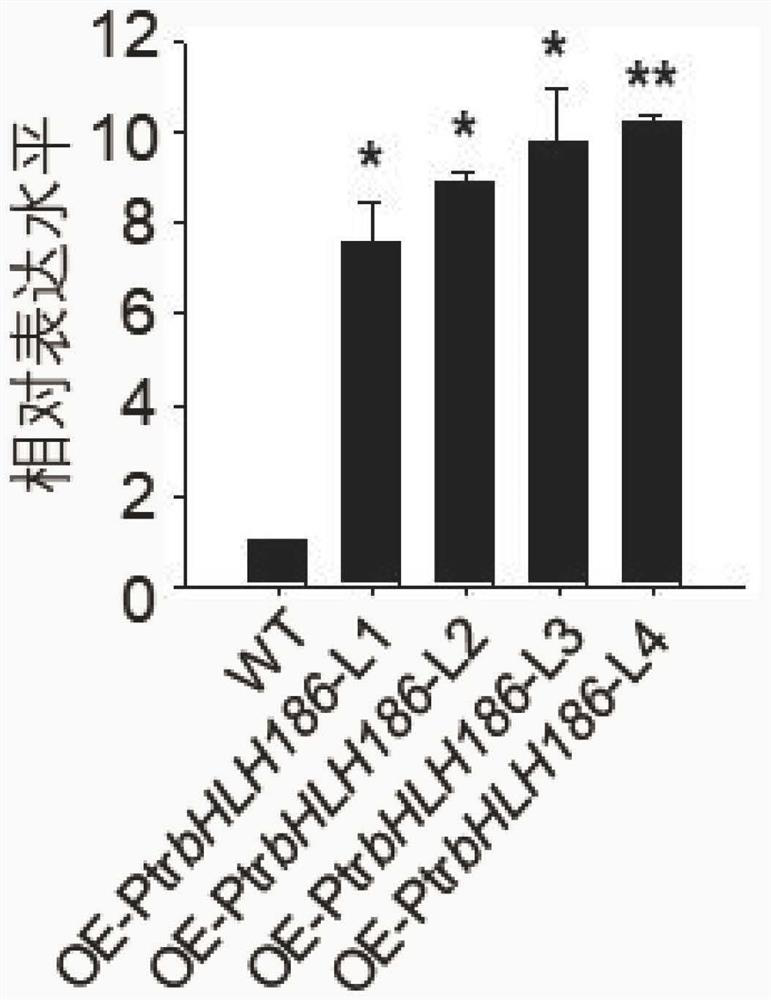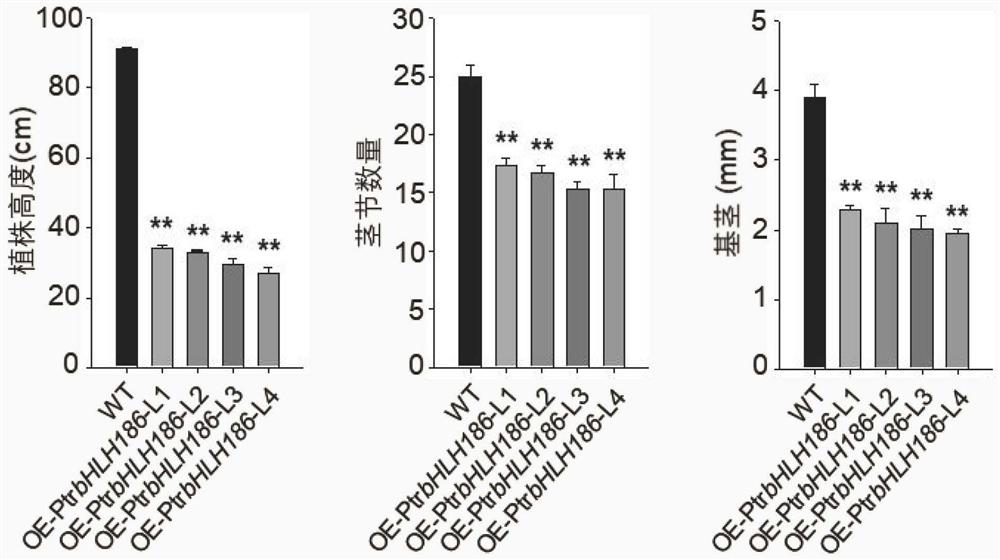Application of ptrbhlh186 gene in Populus trichocarpa in regulating secondary xylem development in trees
A technology of Populus trichocarpa and xylem, applied in the field of genetic engineering, can solve the problems that the biological functions of genes have not been studied
- Summary
- Abstract
- Description
- Claims
- Application Information
AI Technical Summary
Problems solved by technology
Method used
Image
Examples
Embodiment 1
[0029] Example 1: Acquisition of PtrbHLH186 transcription factor of P. trichocarpa and construction of plant expression vector
[0030] (1) Cloning of PtrbHLH186 gene sequence
[0031] The total RNA of the wild-type plants of Populus trichocarpa Nisqually-1 genotype was extracted by Qiagen plant RNA extraction kit, and cDNA was obtained by reverse transcription using Takara reverse transcription kit (RR047A).
[0032] Referring to the genome sequence information of P. trichocarpa provided by the phytozome website, gene-specific primers were designed at both ends of the target gene sequence and a bio-company was entrusted to synthesize the primers. The upstream and downstream primer sequences used for PtrbHLH186 gene cloning are shown in Table 1.
[0033] Table 1 Sequences of upstream and downstream primers used for PtrbHLH186 gene cloning
[0034]
[0035] Note: The underlined part represents the restriction site, and the protection base is in front of the restriction site...
Embodiment 2
[0053] Example 2: Obtainment of PtrbHLH186 Overexpressing Plants of P. trichocarpa
[0054] (1) Freeze-thaw method to transform Agrobacterium
[0055] ①Take out the Agrobacterium competent cells and put them on ice, add about 30 ng of plasmid to the Agrobacterium competent cells, mix well, ice bath for 30 minutes, immediately put them in liquid nitrogen, freeze for 1 minute, and then immediately put them into 37℃, water bath 3min.
[0056] ②Add 1ml of liquid LB and incubate at 180-200rpm at 28℃ for 2-3h.
[0057] ③Break off for 15s, remove the supernatant, retain 300-400 μl of the supernatant, resuspend, plate on LB (kanamycin + gentamicin) solid medium, and culture at 28°C for about 48h.
[0058] ④ Pick the large clone, inoculate it in 5ml LB (kanamycin + gentamicin) liquid medium, and cultivate overnight at 220rpm and 28°C.
[0059] ⑤ Carry out PCR with bacterial liquid as a template to confirm positive clones. Refer to Example 1 for the specific method.
[0060] ⑥ Save ...
Embodiment 3
[0083] Example 3: Application of PtrbHLH186 gene in PtrbHLH186 in regulating tree secondary xylem development
[0084] (1) The independent resistant lines obtained in Example 2 and the wild-type plants of P. trichocarpa were subjected to growth phenotypic analysis
[0085] Growth phenotype analysis includes the following indicators:
[0086] Tree height measurement: The height from the soil surface to the terminal bud was measured for the wild type and transgenic greenhouse plants overexpressing PtrbHLH186 at 1, 2, 3 and 4 months old, respectively. The wild type and transgenic plants were at least 3 biological replicates.
[0087] Number of stem nodes: 1, 2, 3, and 4-month-old wild-type and transgenic greenhouse plants overexpressing PtrbHLH186 were counted for the number of stem nodes. Wild-type and transgenic plants were replicated at least 3 times.
[0088] Basal stem measurement: 1, 2, 3, and 4-month-old wild-type and transgenic greenhouse plants overexpressing PtrbHLH186...
PUM
 Login to View More
Login to View More Abstract
Description
Claims
Application Information
 Login to View More
Login to View More - R&D
- Intellectual Property
- Life Sciences
- Materials
- Tech Scout
- Unparalleled Data Quality
- Higher Quality Content
- 60% Fewer Hallucinations
Browse by: Latest US Patents, China's latest patents, Technical Efficacy Thesaurus, Application Domain, Technology Topic, Popular Technical Reports.
© 2025 PatSnap. All rights reserved.Legal|Privacy policy|Modern Slavery Act Transparency Statement|Sitemap|About US| Contact US: help@patsnap.com



